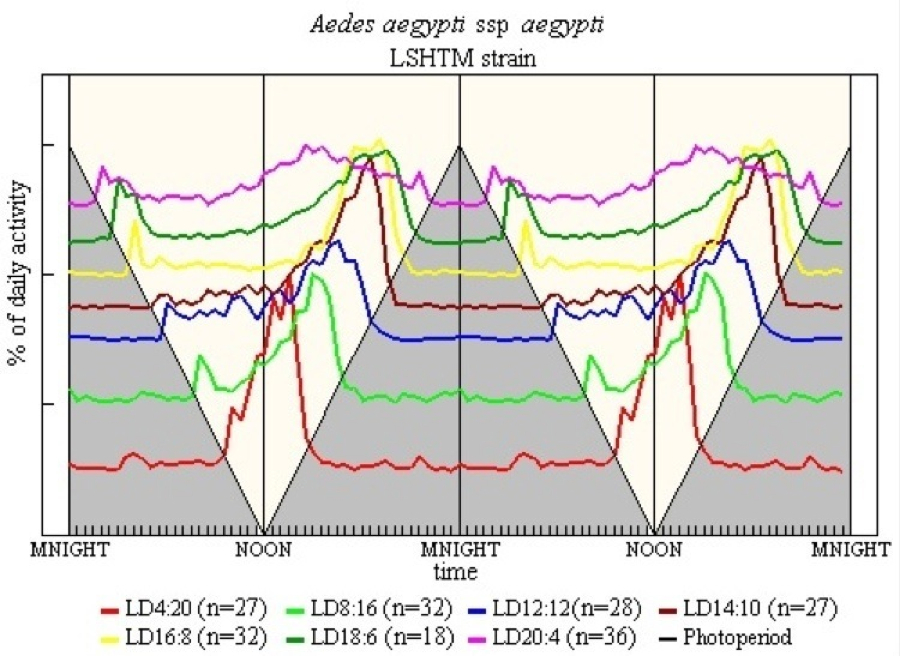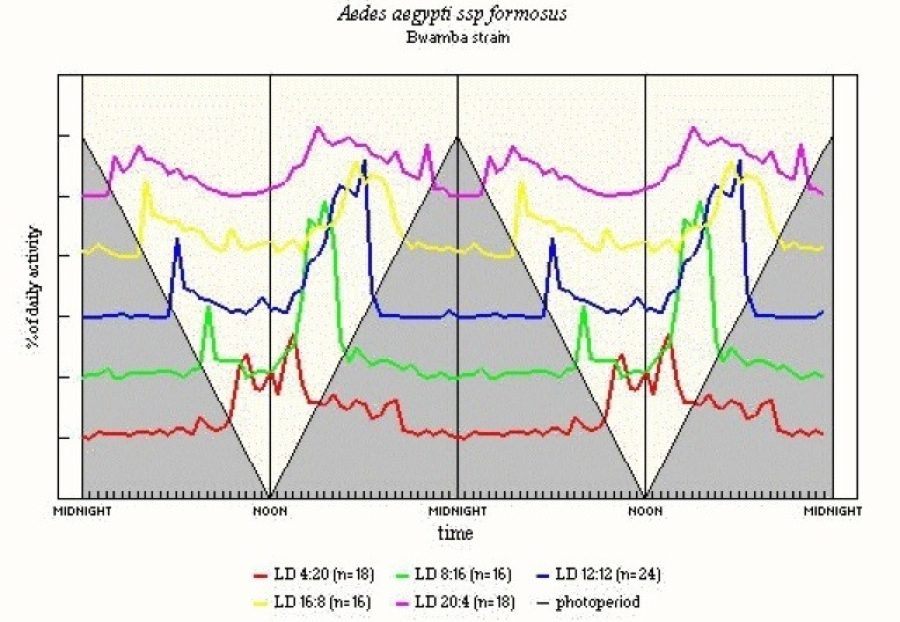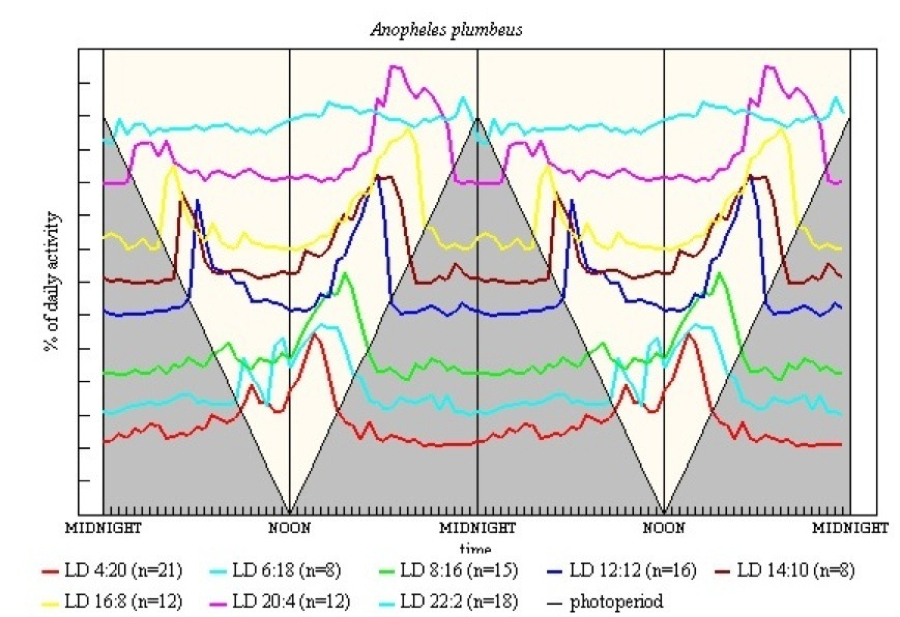
Biological Clocks in Mosquitoes - Section 2
Comparative analysis of the patterns of flight activity under various
photoperiods - Early (strong light) crepuscular species
|
(i) Aedes aegypti
A pan-tropical species, with geographical limits of approximately 40°N
and 40°S. Two subspecies were studied - ssp aegypti and formosus.
Ae. aegypti ssp aegypti, type-form, LSHTM strain
Figure 3 shows the photoperiodogram. The pattern in all seven LD
regimes is dominated by the E' peak. It is clear that when L
> 14h the E' peak falls progressively earlier as L
increases, coming some 13-14h after light-on. Very little activity
follows in the subjective night, and there is a small, variable, M peak
which is rather more pronounced when L > 16h. Low level activity
rises to a peak some 14h after light-off, and can be seen in D when L
< 8h and in L when L > 14h, this is manifest as the broad M in
LD 18:6.
Figure 3

Ae. aegypti ssp aegypti type-form, Ilobi strain
Figure 4 shows the photoperiodogram. The pattern in all five LD regimes
is dominated by the E' peak. It is clear that when L > 12h
the E' peak falls progressively earlier as L increases, coming
some 13-14h after light-on. Very little activity follows in the
subjective night and there is a variable M peak. This is most
pronounced in LD 16:8 and the breadth of the peak suggests entrainment
by light-off . This is echoed by the low peaks in D of LD 4:20 (at
around 0300h) and in L of LD 20:4.
Figure 4

Ae. aegypti ssp formosus wild-form, Bwamba strain
Figure 5 shows the photoperiodogram. The pattern in all five LD regimes
is dominated by the E' peak. There is some activity in the
subjective night, most obviously in LD 4:20 with a minor peak 3-4h
after light-off. It is clear that when L > 12h the E' peak
falls progressively earlier as L increases, coming some 14-15h after
light-on. This light-on entrainment is reflected by the continuance of
activity in D when L < 12h. There is a clear M peak, which
becomes broader when L > 12h, peaking at 2-2.5 h after light-on in
LD 20:4.
Figure 5

Ae. aegypti ssp formosus wild-form, West Nile
strain
Figure 6 shows the photoperiodogram. The pattern in all five LD regimes
is dominated by the E' peak and there is very little activity
in the subjective night. It is clear that when L > 12h the
E' peak falls progressively earlier as L increases, coming some
14-15h after light-on. There is a clear M peak in all the LD
regimes, and this becomes broader when L > 12h, peaking at 2-2.5 h
after light-on in LD 20:4.
Figure 6

(ii) Anopheles plumbeus
A species of the western Palaearctic found from the northern limits of
oak, around 58°N, south to around 35°N. Figure 7 shows the
photoperiodogram. The pattern in all eight regimes is dominated by the E'
peak. It is clear that when L > 14h the E' peak
falls progressively earlier as L increases, coming some 15-16h after
light-on. In both LD 20:4 and LD 22:2, even more so in the latter,
there is evidence of a burst of activity in the first 0.5h after
light-off. A "shadow" E' peak can be seen after light-off in
the short-L regimes. In all regimes between LD 12:12 and LD 16:8 there
is also a pronounced, but shorter in duration, M peak.
Although in the mid-range LD regimes there is very little activity in
the subjective night, there is evidence of increased activity some
8-12h after light-off when L < 12h, and this perhaps is seen also
some 6h after light-off (i.e. 4-5h after light-on) in LD 22:2.
Figure 7

(iii) Culex pipiens molestus
A widely distributed species of Eurasia, south of about 40°N. For
comparative purposes, Figure 8 shows a photoperiodogram derived from
results published by Chiba & Tomioka (1992), who used a colony
originating from Iran. The E' peak, which is precisely defined
in L 12-16h, clearly shifts forward when L > 16h and this light-on
entrainment is reflected in small post-light-off activity in
LD 4:20. Marked light-off entrainment gives a peak some 10-12h
later in all regimes, this is most notable as the pronounced M in
the mid-length LD regimes. In the paper by Chiba & Tomioka (1992),
data for LD 21:3 and LD 22:2 also showed the late M and early
E'.
Figure 8

Discussion
These are species which, when L 12-16h, show a broad peak of E' activity
for 3-4h before light-off, and, more variably, an M peak. The
results are for Ae. aegypti ssp aegypti, LSHTM strain
and Ilobi strain; Ae. aegypti ssp formosus, Bwamba
strain and Ilobi strain; An. plumbeus; and Cx. p. molestus.
Initial studies on Ae. aegypti LSHTM (especially on
phase-setting, LD 12:12 to DD, and LL to DD) had indicated that the
prime entrainment of E' was by the last light-off (Taylor
& Jones, 1969). However, both the ssp aegypti strains,
LSHTM and Ilobi (see Figures 3 and 4), show clear advancement of E'
when L > 14h, indicating that E' is entrained
also by light-on some 12-14h earlier. In LD 4:20, moreover, Ilobi shows
the regular light-off entrained E' and a "shadow" E' peak
some 4h after light-off, i.e. at least 8h after light-on. In both
strains, activity in LD 4:20 shows a small rise 13-14h after light-off,
which is reflected in the broad M in LD 20:4, and in LD 16:8
in Ilobi. The ssp formosus strains, Bwamba and West Nile (see
Figures 5 and 6), show a similar pattern which is more strongly bimodal
than that of ssp aegypti. The E' peak is sharper and
the light-on entrainment is vividly revealed in LD 20:4, where E' is
12-13h after light-on, and when L £ 8 h
where continuance (and even small peaks) of activity is shown after
light-off. The M peak is pronounced in all LD regimes, being
broad in longer L regimes and delayed in LD 20:4. The latter delay may
be evidence of entrainment by the previous light-off. Alternatively, it
can be argued that there is an underlying bimodal rhythm, with peaks
separated by 12h and M suppressed in extended D.
The observations on An. plumbeus (see Figure 7) show a
remarkably similar pattern to that of Ae. aegypti, with the
main difference being that the entrainment period of E' by
light-on is some 16h. This is obvious in LD 20:4 and is supported by
small peaks after light-off in all regimes with L < 16h.
Activity resurgence some 8-10h after light-off can be seen in the LD
regimes with L shorter or longer than 12-16h.
The Cx. p. molestus results come from the work of Chiba
& Tomioka (1992), whose data were presented as activity/hour, hence
the somewhat cruder photoperiodogram (see Figure 8). They regarded the
pattern as diphasic and synchronised with the LD ratio. The M peak
follows light-off by some 8h, fitting well with the natural summer
daylength of its home range (up to about 40°N). The E' peak
was noted as being advanced faster in relation to light-off as the L
increased. In LD 22:2 (not shown in the photoperiodogram) they found
activity which "may be outside the entrainable range". Examination of
their result for LD 20:4, plus that for LD 21:3 (also in their paper),
suggests conformity with the light-on entrainment, i.e. following
light-on by some 16h. This is supported also by the low level activity
after light-off in short L regimes.
 NEXT
NEXT

©1998, 2010 - Brian Taylor CBiol FSB FRES
11, Grazingfield, Wilford, Nottingham, NG11 7FN, U.K.
Comments to dr.b.taylor@ntlworld.com
|
href="\crhtml\ppgram3.htm"







